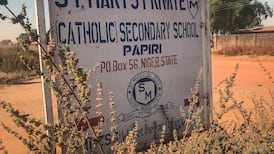After years of wrangling over Ethiopia's controversial dam on the Blue Nile, the massive turbines have begun producing electricity, generating fear in Egypt and Sudan that the life-giving flow of the river will be seriously reduced by the diversion of water to fill a vast lake behind the barrier.
While Ethiopia argues the $4.2 billion (€3.7 billion) Grand Ethiopian Renaissance Dam is essential for development, Egypt and Sudan say the dam, the largest in Africa, could deprive them of their fair share of the Nile waters, which have nourished crops since ancient times. Egypt's seminal civilisation, 3,100-30 BC, depended on Nile floods.
The nearly-completed dam, which captures 85 per cent of the Blue Nile’s flow, is expected to double Ethiopia’s electricity, provide power to 60 million of the country’s 116 million people and contribute to the development of infrastructure, manufacturing, and health and educational systems.
The Blue Nile originates in Ethiopia and is a major tributary of the river Nile.
Start-and-stall negotiations have soured relations between the parties ever since construction began in 2011. While Sudan expects benefits from the dam, including electricity, it says 20 million Sudanese could lose irrigation water.
The Nile flow is a matter of life and death for Egypt, which has warned that “all options remain on the table”, meaning the use of military force if its needs are not met.
Ethiopia has refused to abide by the 1997 UN Watercourses Convention compelling upstream states to consult downstream countries when initiating mega projects, or to provide a commitment on the amount of water Egypt would receive once the dam is completed.
Water poverty
Egypt is highly vulnerable because it has reached the water poverty level of 550-560 cubic meters per capita a year, about half the minimum global water level required to sustain decent life.
Former Egyptian irrigation minister Mohamed Nasr al-Din Allam told Al-Monitor: “For 30 years, we have been suffering from water poverty and from a food gap, because we produce less than we consume.” Consequently, Egypt has been compelled to import food due to the shortage of water.
Egypt’s share of Nile water has not increased during this time to keep up with population growth, he said. “This means that Egypt’s annual share of water amounts to 60 billion cubic metres, while the country needs 114 billion cubic metres” to provide for its 102 million inhabitants.
“Therefore, compromising Egypt’s share of the Nile water is a red line,” he stated. Egypt “will not allow this major problem to continue because of Ethiopia’s unilateral actions”.
Mr Allam said Cairo wanted to resume negotiations to reach a "binding legal agreement on the mechanisms of operating the dam". The African Union, which has previously mediated talks, has been urged to resume its effort to end the stand-off, which could precipitate a major crisis between Egypt and Ethiopia.










